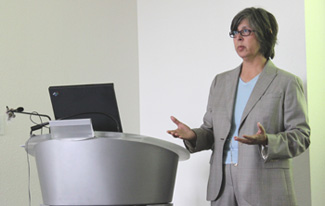The Science of Human Research Protection
August 11, 2010 / By Anna Lynn Spitzer
|
Research is multi-faceted, as this summer’s SURF-IT undergraduates are quickly learning. One of the most essential components for many projects is the protection of the human research subjects participating in them.
During last week’s SURF-IT lunchtime seminar, Karen Allen, director of UCI’s human research protection program, shared the history and ethical principles involved in protecting research participants from physical, psychological or social harm.
She explained the ways in which the university’s Institutional Review Board protects the rights and welfare of human research subjects. UCI’s IRB is comprised of three separate committees: two dedicated to biomedical research and the third to social and behavioral investigations.
She also discussed the historical origin of those protections, starting with atrocities committed by Nazi scientists in the name of research. The Nuremberg Code, developed in response to those war crimes, contains elements that informed the United States’ National Research Act in 1974 and ultimately, 1979’s Belmont Report, which requires that all human research in the U.S. meet criteria for respect, beneficence and justice.
Specifically, subjects are entitled to voluntary, informed consent without coercion, and a guarantee that the risks will not outweigh the benefits to research, she said. In addition, vulnerable populations – children, the cognitively disabled, prisoners and pregnant women – must be afforded additional protection.
The U.S. has its own history of questionable human research. The Tuskegee Syphilis Study, which began in 1932, was supposed to last six months. It actually lasted 40 years, during which time participants had no way to opt out and were denied treatment that could have cured them.
The Milgram Experiment in 1961 raised a host of other ethical issues, including research under false pretext, misleading the subjects during the experiment and pressuring them to continue after they asked to stop.
Today, institutional review boards determine a protocol’s suitability based on a number of criteria. Are risks minimized? Do the benefits of the research outweigh the risks? Is the selection of subjects equitable? Other factors include the acquisition of informed consent, the protection of privacy and confidentiality, the necessity of data and safety monitoring, and appropriate additional safeguards for vulnerable populations.
Allen also detailed different levels of review and of informed consent, both of which are based on the risk present in the research. While the regulatory definition of minimal risk involves the anticipated probability and magnitude of harm or discomfort to participants, UCI has amended the definition to include a comparison to “daily lives of the general population.”
“As opposed to having a relative definition of minimal risk, we have a definitive definition,” she said. “The risks could be different depending on the perspective of the comparison group.”
Very low-risk research often is exempted from IRB review, while minimal-risk research may be expedited by an IRB subcommittee. When the risk is deemed greater than minimal, projects require review by the whole board. Both expedited and full-committee research must be reevaluated annually in order to ensure a “continuing process,” Allen said.
Informed consent, which she called “the hallmark of human subjects protections,” also varies depending on the research’s risk level. It ranges from a single sheet of paper to a 30-page document. “It’s not a single point in time; rather, it’s really a process,” she said. “We need to provide the information, [potential subjects] need to be able to understand it and they need to make sure their participation is voluntary.”
She urged researchers who aren’t sure whether their work requires IRB approval to investigate the Human Research Protections website or email the HRP staff. Students with questions should talk to their faculty advisors or learn more at www.research.uci.edu/ora/hrpp/studentresearchers.htm.
-- Anna Lynn Spitzer
Presentation part 1
Presentation part 2
PowerPoint presentation


